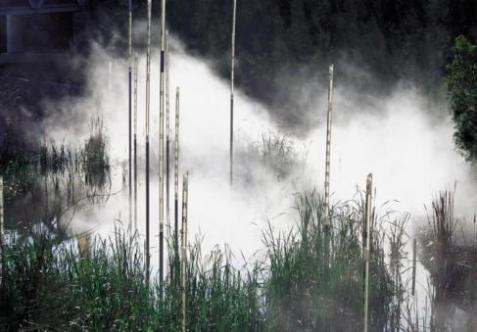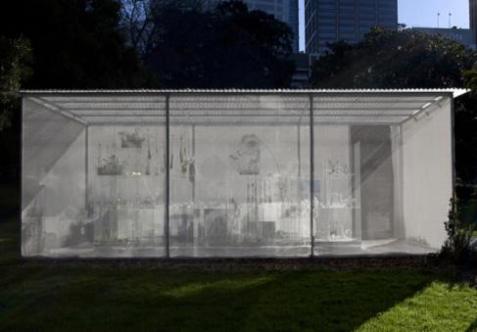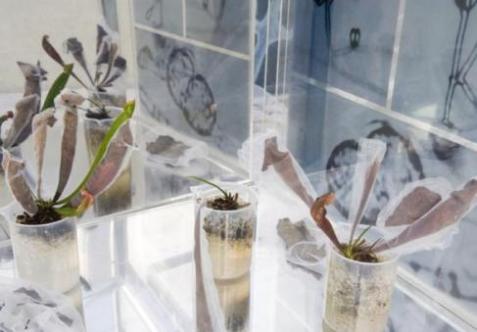The work of Janet Laurence, an Australian site-specific artist, aims to create spaces which cause viewers to contemplate their relationship to the plant life that we are surrounded by. Her work deals with the way in which human activities such as deforestation and soil degradation are destroying landscapes and disconnecting us from the natural environment.
As she described in an interview in Felicity Fenner in Art and Australia magazine in 2010: “The future of many plants is in danger, yet they are central to the earth and existence of all animal life. We are dependent on them for everything from the air we breathe to the food we eat. Plants are organic, not static, objects… Working with living plants you become very aware of their being, their needs and internal processes.” (Janet Laurence, quoted in Art and Australia, Spring 2010, p.64)

In the Shadow, 2000, Sydney, http://www.janetlaurence.com/in-the-shadow/
Janet Laurence uses her artistic practice to draw attention to environmental issues such as climate change and its effect on the plant life that we all depend upon. Laurence’s work highlights both the fragility and the importance of plant life and aims to generate a new respect for the flora that helps to sustain our existence.
Her site-specific piece, In the Shadow, aimed to repair the natural vegetation in Sydney’s Olympic Park in Homebush bay. As well as extensive planting of native plant species, this piece included the installment of twenty-one vertical wands which monitored the chemistry of the river water. By encouraging the growth of native plants in a suburban area of Sydney, In the Shadow, “oxygenates an otherwise quite sterile precinct.”(Felicity Fenner, Art & Australia, p.64)
Laurence believes that “art can bring into public view some confronting environmental issues that without the imprimatur of it being a creative work wouldn’t ordinarily be presented, because so often scientific information is not permitted public access. So, as an artist, the Olympic Park commission was a major opportunity for me – not just to install a work, but to heal an environment.” (Janet Laurence, quoted in Art and Australia, Spring 2010, p.64)
As well as drawing attention to the environmental issues she is engaging with, Laurence’s work is a type of direct action. She uses art as a means to take action to preserve organic landscapes. Part of Laurence’s work includes revitalising plants that are damaged or suffering, such as in Waiting – A Medicinal Garden for Ailing Plants, which was exhibited at the 2010 Sydney Biennale.

Waiting – A Medicinal Garden for Ailing Plants, 2010 Sydney Biennale, http://www.janetlaurence.com/waiting-a-medicinal-garden-for-ailing-plants/
This work consisted of a mesh structure containing numerous plant species which were wrapped in soft netting and connected through tubes containing fluids to aid in their regeneration. It was intended to function as a plant hospital – a place not only for viewers to contemplate the effect human activity has on the natural environment, but also a place where unhealthy plants could heal and florish. While this small space worked to physically rejuvenate plant life, the work as a whole symbolises the plight of many endangered plant species in this time of increasing environmental degradation.

Waiting – A Medicinal Garden for Ailing Plants (detail), http://www.janetlaurence.com/waiting-a-medicinal-garden-for-ailing-plants/
“I try to create a space somewhere between evidence and imagination. While my practice is based on deeply held convictions about the environment and our relationship to it – and I want the work to have a politically environmental voice – I think it’s important that viewers make their own journey and experience it as a space of reflection and interpretation.” (Laurence, Art and Australia, p.67)
Here, Laurence defines the place of her work on the spectrum of art and activism. Her work has a strong environmentalist message, but her approach to this is one which encourages viewers to interpret her meaning in their own time. Laurence sees this process of understanding and comprehending the meaning of her work as being a strategy for engaging viewers more deeply in environmental issues than an information-based activist campaign, as, she believes that “art, if it engages, can linger in the mind the way that pure information can’t.” (Laurence, Art and Australia, p.67)
Michelle Gearon








02Oct / 2012
Wheatfield – a confrontation…
“Artists are not locked into a single discipline. Art is a specialization that need not feed upon itself. It is capable of imbibing key elements from other systems, unifying them into a unique and coherent vision. The new role of the artist may be to create an art that is more than decoration, commodity, or political tool. It is an art that questions the status quo and the direction life has taken, the endless contradictions we accept and approve. An that elicits and initiates thinking process has the power to make statements with universal validity and thus benefit humanity.”
Agnes Denes 1992.
Agnes Denes is a pioneer, an activist, a conceptual and environmental artist… and until very recently, I had never heard of her. I am now finding this quite astonishing considering one of her most notable works Wheatfield- A Confrontation (1982), saw the artist plant a two acre wheat field in lower Manhattan, two blocks from Wall Street and the World Trade Center, facing the Statue of Liberty, in what is now known as Battery Park.
Brain Sholis, writing in Artforum noted both the “simple generosity” of the work (Denes harvested one thousand pounds of the crop that August and planted it around the globe) and that “Wheatfield–A Confrontation and can be understood as one of the first occasions on which Denes worked on a scale large enough and in a location public enough to suit her outsize ambition. The intervention represented, in the artist’s words, nothing less than ‘food, energy, commerce, world trade, economics. It referred to mismanagement, waste, world hunger, and ecological concerns’.”
According to the artist the work “called attention to our misplaced priorities. The harvested grain traveled to twenty-eight cities around the world in an exhibition called “The International Art Show for the End of World Hunger”, organized by the Minnesota Museum of Art (1987-90). The seeds were carried away by people who planted them in many parts of the globe”.
At the time, this part of Manhattan was a landfill but the real-estate was worth more than $4.5 Billion dollars. In this work Denes distilled both the paradox and the tragedy inherent in the socio-cultural power structures of the western world. To my mind, this work continues to resonate, and even takes on new significance in our post 9/11, post GFC world. The location of Wheatfield- A Confrontation has been so significantly tied to both these aforementioned events. In 1982 Denes asked the people of Manhattan, of America, of the First World, to “renthink their priorities and realise that unless human values were reassessed, the quality of life, even life itself, was in danger”. In the artist’s words, “Wheatfield was a symbol and a universal concept.“
This work draws my attention to the importance of the archive and the artistic document. Although this work was only a temporary eco-intervention, through its documentation, its power and resonance is ongoing. Wheatfield, in its defiant absurdity and ambition, reminds us that our world is this way because we will it to be, or we allow it to be. It is about agency, responsibility and our priorities, not just environmental, but social, cultural and political too.
Jane Diserio
Read more about Agnes Denes here.
Posted in Comment on Consumption, interventionist art
Permalink Leave a comment